
Everyone has a poor attitude or bad day once in a while. Unfortunately, there are those whose bad attitude permeates their very being. Bad attitudes can be for a number of reasons.
- Victim thinking
- Some find it difficult to move beyond major disappointments in life.
- An induvial may be clinically depressed.
- Others think the world owes them a living and can’t understand why everything in life is so difficult.
- Some people are grudge holders for whatever cause or reason
- Many people find change more difficult than others.
As a leader, are these your fault? Certainly not. As a leader are you the one who has to deal with these attitudes? Yes, but maybe not in the way you may think.
 Organizations need employees with up to date skills. “So, develop them already!”, you say. Certainly, there is no scarcity of avenues to pursue for development. A recent study lists six: 1) formal off-the-job training, 2) formal on-the-job training, 3) upward and 4) lateral internal job transition, 5) job resource autonomy, and 6) skill utilization. However, employee development is not without its issues. According to one CEO, it’s difficult to keep up as the need for different skill sets changes rapidly. The other is the fear that an employee who enjoys development on your dime, will take those newly developed skills to your competition. Ouch!
Organizations need employees with up to date skills. “So, develop them already!”, you say. Certainly, there is no scarcity of avenues to pursue for development. A recent study lists six: 1) formal off-the-job training, 2) formal on-the-job training, 3) upward and 4) lateral internal job transition, 5) job resource autonomy, and 6) skill utilization. However, employee development is not without its issues. According to one CEO, it’s difficult to keep up as the need for different skill sets changes rapidly. The other is the fear that an employee who enjoys development on your dime, will take those newly developed skills to your competition. Ouch!
According to the same study, there is only one development technique that encourages employees to go elsewhere and that is a promotion. However, there is a way to combat that by offering portfolio careers. Portfolio careers are careers in which individuals contract their skills and knowledge to multiple organizations, thereby building a portfolio of skills and experiences. Of course, any development program must be effective and here are a few ideas.
DID YOU KNOW THAT THE FAILURE RATE FOR NEW MANAGERS IS *46%!?
Why was the First Time Managers Coaching Program Created?
As a former manager in human resources, witnessing the promotion of unqualified people to management was heartbreaking. And the failure rate was proving costly. As an executive coach, I can see these failures manifest when there is a lack of solid leadership training.
New managers rarely have the training they need, and certainly don’t have any of the experience an executive possesses. Indeed, most new managers are promoted primarily because they are doing a good job in their current position. That doesn’t necessarily make them management material.
The executive staff are the people who get the resources such as training, off-site retreats, and coaching. Of course, it is a good idea to put resources behind the executive staff because, after all, they are carrying a lot of risks for the success of the organization.
But think about this. New managers are the people who could one day fill the shoes of an executive in your organization. I dare say that any executive you speak with wishes he or she had more “care and feeding” about how to manage and lead as they started up and continued to climb the ladder into the executive suite.
That’s why I’ve created a coaching program specifically designed for managers with zero to three years’ experience. This program is affordable, so the organization can not only justify, but recoup the investment, and reap benefits the company will profit from for years to come.
Schedule an Appointment
How does the First Time Managers Program Work?
The new manager takes the TriMetrix HD Assessment, and receives a report consisting of:
- Behaviors:
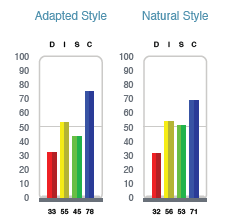
Behavioral research suggests that the most effective people are those who understand themselves, both their strengths and weaknesses, so they can develop strategies to meet the demands of their environment. This report measures the four dimensions of normal behavior: dominance, influence, steadiness, and compliance.
TriMetrix HD tells how the new manager will perform.
*Source: HR.com
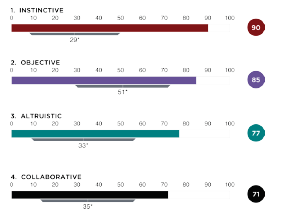 Knowledge of an individual’s driving forces helps tell us why a person behaves a certain way. 12 Driving Forces ™ measures an individual’s top four of driving forces to tell a story of how a person derives meaning from life and work.
Knowledge of an individual’s driving forces helps tell us why a person behaves a certain way. 12 Driving Forces ™ measures an individual’s top four of driving forces to tell a story of how a person derives meaning from life and work.
TriMetrix HD illuminates what drives this individual’s behavior – the why behind their actions.
- Competencies:
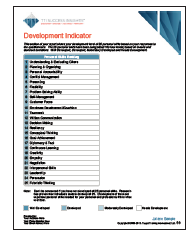
An individual’s hierarchy of competencies, including his/her leadership score, is key to their success. Knowing what they are is essential to reaching one’s goals. This report is designed to assist managing and developing a career. For many jobs, personal skills are as important as technical skills in producing superior performance.
TriMetrix HD describes what this individual “has done” in 25 research-based competencies related to the business environment.
Acumen Capacity Index:
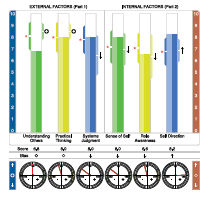
The Acumen Indicators section is designed to help individuals truly understand themselves and how they analyze and interpret their experiences. A person’s acumen, keenness, and depth of perception or discernment is directly related to performance.
TriMetrix ACI explores both how a person’s judgment impacts interaction with the external world, and his or her own self-perception.
In addition, the assessment reports contain self-coaching strategies that will guide the new manager beyond the coaching initiatives of this program.
Schedule an Appointment
Program Structure
Online assessment administration
3 months or 12 hours of coaching (Bonus: 1 extra hour at no charge in the first session!)
Unlimited access to the coach via phone and email during the coaching program
The Program is Designed To:- Increase clarity, focus, and direction
- Create a specific strategy and a plan to reach goals
- Build or enhance necessary skills
- Create a supportive environment to achieve success
- Deal with barriers that block goal achievement
Coaching Topics Include, but Are Not Limited To:
- Leadership myths and magic
- Understanding roles and responsibilities
- Critical/strategic thinking
- Handling relationships (former peers and supervisor)
- Understanding your team’s history
- Understanding performance management
- Communication
- Problem analysis and decision making (including making hard decisions)
- Creating a culture of accountability
- Motivating your team
- Coaching
- Evaluating your team
- Continuous learning and trends
Why am I Qualified to Coach?
- Ten years of coaching executives from a variety of industries across the United States and from Israel, Chile, South America, Japan, Germany, China, and Sweden.
- Certifications include: Registered Corporate Coach (RCC), Leaders Coaching Leaders Coach (LCL) and Facilitator, Certified Professional Driving Forces Analyst (CPDFA); (CPBA); (DISC Certified); Certified TriMetrix HD Analyst (CPHDA), and Certified Professional Emotional Quotient Analyst (CPEQA)
- Formal education includes a Masters of Arts in Industrial Organizational Psychology and a Bachelor of Science in Psychology
- Six years as a Human Resource Manager
Bonus I:
One complimentary extra hour of coaching in the first session, for a total of 14 hours of coaching.
Bonus II:
Diane’s eBook, How to Give Dull, Boring Meetings a Swift Kick in the Agenda. This book provides the new manager with insights on:
- How to manage different behavioral styles in meetings
- How to determine if a meeting is necessary
- Types of meetings
- How to have more effective meetings
- Ways to make meetings fun!
Bonus III:
A complimentary “check-in” call 3 months after our final session to help ensure the new manager is still on track. This brings the total number of coaching hours to 15!!
Let's get started to give your managers the leadership foundation they need to make it all the way to the Executive Suite!
 Losing weight and managing have a lot in common. Both losing weight and managing people are difficult. If you’re overweight, you may often receive negative feedback about how your weight is affecting your health from family, friends, and your doctor. One of the most difficult tasks in managing people is giving negative feedback or terminating them. It just so happens that employees with bad attitudes, low performers, and the good days/bad days employees are weighing you and your department down just as excess body weight slows your body down.
Losing weight and managing have a lot in common. Both losing weight and managing people are difficult. If you’re overweight, you may often receive negative feedback about how your weight is affecting your health from family, friends, and your doctor. One of the most difficult tasks in managing people is giving negative feedback or terminating them. It just so happens that employees with bad attitudes, low performers, and the good days/bad days employees are weighing you and your department down just as excess body weight slows your body down.
Of course, the idea is to always try and keep employees by finding a way for them to add value. The employee might be able to contribute by performing different tasks on your team. They may be a better fit for another team in the same area, or they might be able to move to a different area of expertise, or location. On the other hand, allowing a poor performer, or a person with a bad attitude, or an employee who engages in unethical behavior to remain on your team is like carrying around 600 pounds of excessive baggage. However, if you feel the employee is salvageable, to ensure both yourself and the employee that you have made every effort to give them a fair chance, a good idea is to create a performance improvement plan (PIP).
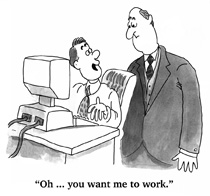
A colleague of mine, Kelly (Allen) Vandever, Leadership & Communications Speaker, Trainer and Coach. Host of the Leadership Podcast Permission to Speak recently posted an excellent article. Rather than regurgitating the article, you can read it in full here “Respect” In a nutshell, the article is about a manager lamenting the fact that her direct reports do not turn projects in on time or at all. She asked a colleague to step in and the colleague advised her that she has lost the respect of her direct reports. Well if they haven’t, they certainly will now by asking a colleague to step in and do her job. Did the respect mysteriously disappear or did she ever have it? The article is well-written and makes some important points about the mysteries of management.
- Inform your reports about the “why” of a project. Check! This helps them to take the mystery out of the big picture and to see how important their position is to the larger goals of the organization.
- Make it OK to Push Back. Check! Creating an environment that allows for back and forth commentary and analysis is healthy and productive. Nothing mysterious here.
- Be Respectful of Your Employees. Duh! Err I mean Check! It’s no secret that basic, human respect is Management 101.
In the article, Kelly goes on to make some other important points.
What else could the manager do to ensure that she gets the job done through her people, and not “mysteriously” lose respect in the process?

 Organizations need employees with up to date skills. “So, develop them already!”, you say. Certainly, there is no scarcity of avenues to pursue for development. A recent study lists six: 1) formal off-the-job training, 2) formal on-the-job training, 3) upward and 4) lateral internal job transition, 5) job resource autonomy, and 6) skill utilization. However, employee development is not without its issues. According to one CEO, it’s difficult to keep up as the need for different skill sets changes rapidly. The other is the fear that an employee who enjoys development on your dime, will take those newly developed skills to your competition. Ouch!
Organizations need employees with up to date skills. “So, develop them already!”, you say. Certainly, there is no scarcity of avenues to pursue for development. A recent study lists six: 1) formal off-the-job training, 2) formal on-the-job training, 3) upward and 4) lateral internal job transition, 5) job resource autonomy, and 6) skill utilization. However, employee development is not without its issues. According to one CEO, it’s difficult to keep up as the need for different skill sets changes rapidly. The other is the fear that an employee who enjoys development on your dime, will take those newly developed skills to your competition. Ouch!
 Knowledge of an individual’s driving forces helps tell us why a person behaves a certain way. 12 Driving Forces ™ measures an individual’s top four of driving forces to tell a story of how a person derives meaning from life and work.
Knowledge of an individual’s driving forces helps tell us why a person behaves a certain way. 12 Driving Forces ™ measures an individual’s top four of driving forces to tell a story of how a person derives meaning from life and work.

 Losing weight and managing have a lot in common. Both losing weight and managing people are difficult. If you’re overweight, you may often receive negative feedback about how your weight is affecting your health from family, friends, and your doctor. One of the most difficult tasks in managing people is giving negative feedback or terminating them. It just so happens that employees with bad attitudes, low performers, and the good days/bad days employees are weighing you and your department down just as excess body weight slows your body down.
Losing weight and managing have a lot in common. Both losing weight and managing people are difficult. If you’re overweight, you may often receive negative feedback about how your weight is affecting your health from family, friends, and your doctor. One of the most difficult tasks in managing people is giving negative feedback or terminating them. It just so happens that employees with bad attitudes, low performers, and the good days/bad days employees are weighing you and your department down just as excess body weight slows your body down. 